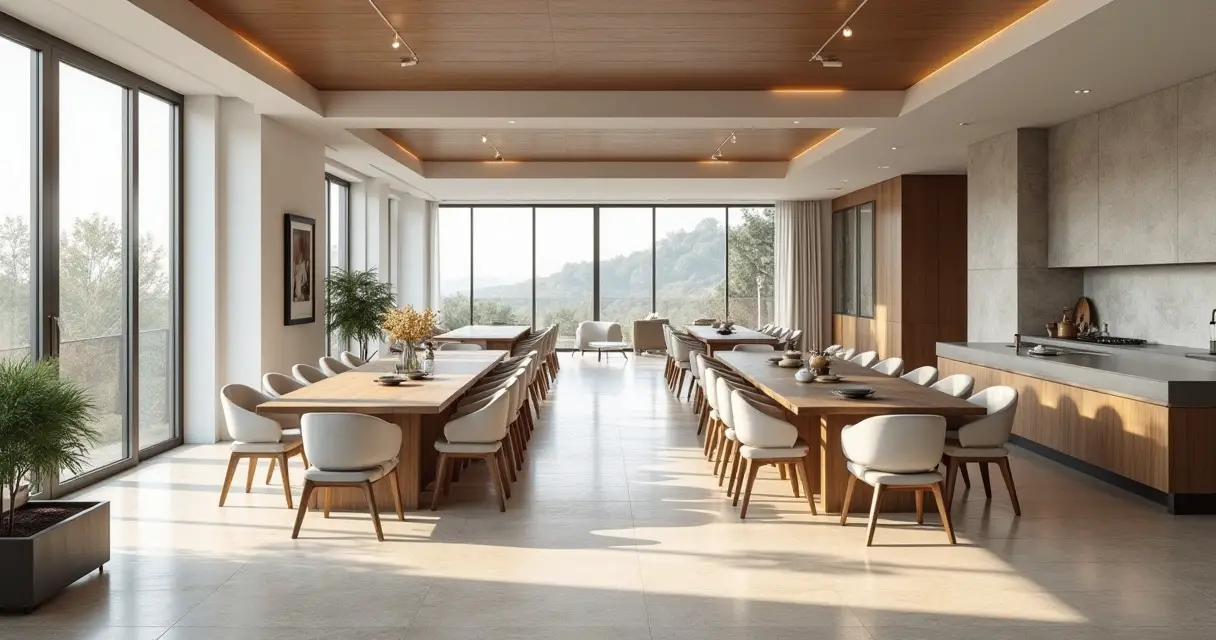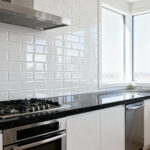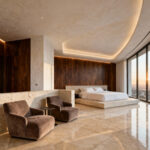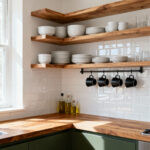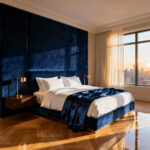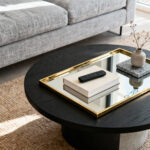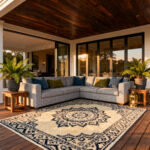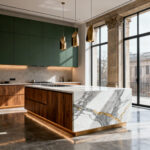You know what people always ask me about creating a truly luxurious dining room? They come with images of impossibly grand spaces, asking how to replicate a look. But that’s where they get it wrong from the start. A dining room isn’t a museum exhibit. It’s not about creating a static photo for a magazine.
The single most important quality of an exceptional dining room is what I call the “linger factor.” It’s the intangible feeling that makes your guests lean back in their chairs after dessert, swirl the last of their wine, and lose all track of time. It’s where conversation flows effortlessly because everyone is just so comfortable. Most people are so focused on the visual—the “wow” moment—that they completely forget the experience. But the experience is the luxury. So let’s talk about how to get it right.
Laying the Foundation: Planning for Your Dream Dining Space (Part 1)
Alright, so before you even think about buying a single thing, we need to talk about the blueprint. The foundation of a room is everything, and skipping these steps is like building a house on sand. This is the unglamorous part, but it’s where truly good design happens. It’s what separates a room that just looks good from one that feels and functions beautifully.
1. Evaluate Room Size and Traffic Flow for Optimal Layout
Forget the furniture for a moment. Get out your tape measure. The single biggest mistake I see clients make is falling in love with a gargantuan table that ultimately suffocates the room. They forget that people have to move around it. A gracious host never forces their guests to do that awkward, apologetic shimmy behind someone’s chair. You need space.
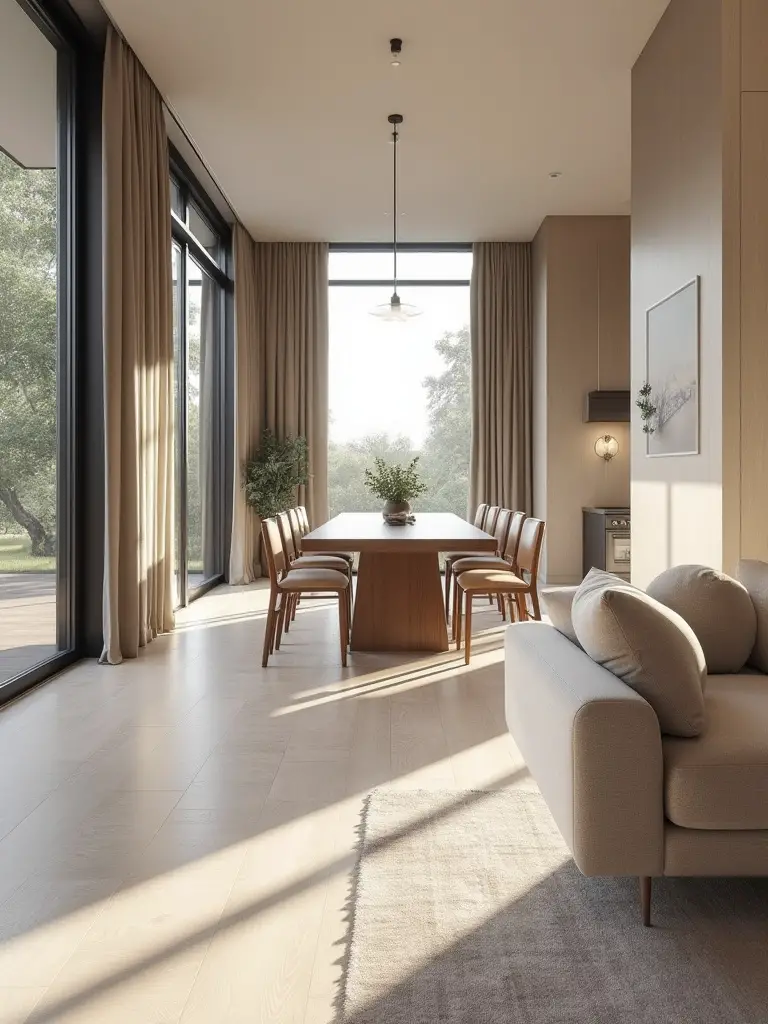
The non-negotiable rule is to leave a minimum of 36 inches—ideally closer to 48—between your table’s edge and the wall or any other piece of furniture. This is your breathing room. It’s the difference between comfort and chaos. I once had a client who bought a stunning 10-foot vintage table for a 14-foot room. It looked incredible empty, but during their first dinner party, no one could get up without forcing three other people to stand and move. The evening felt stilted and uncomfortable. They sold the table at a loss six months later.
A shortcut I insist on: use painter’s tape to mark out the footprint of your desired table and chairs on the floor. Live with it for a day. Walk around it. You will know immediately if you’ve been too ambitious.
2. Define Your Dining Room’s Primary Function and Usage
Now for some honesty. How will you actually use this room? The fantasy of hosting weekly, 12-person formal dinners is lovely, but what’s the reality? Does your dining table double as your work-from-home office? Is it where the kids do their homework? Is it truly just for special occasions? Be brutal with the truth.
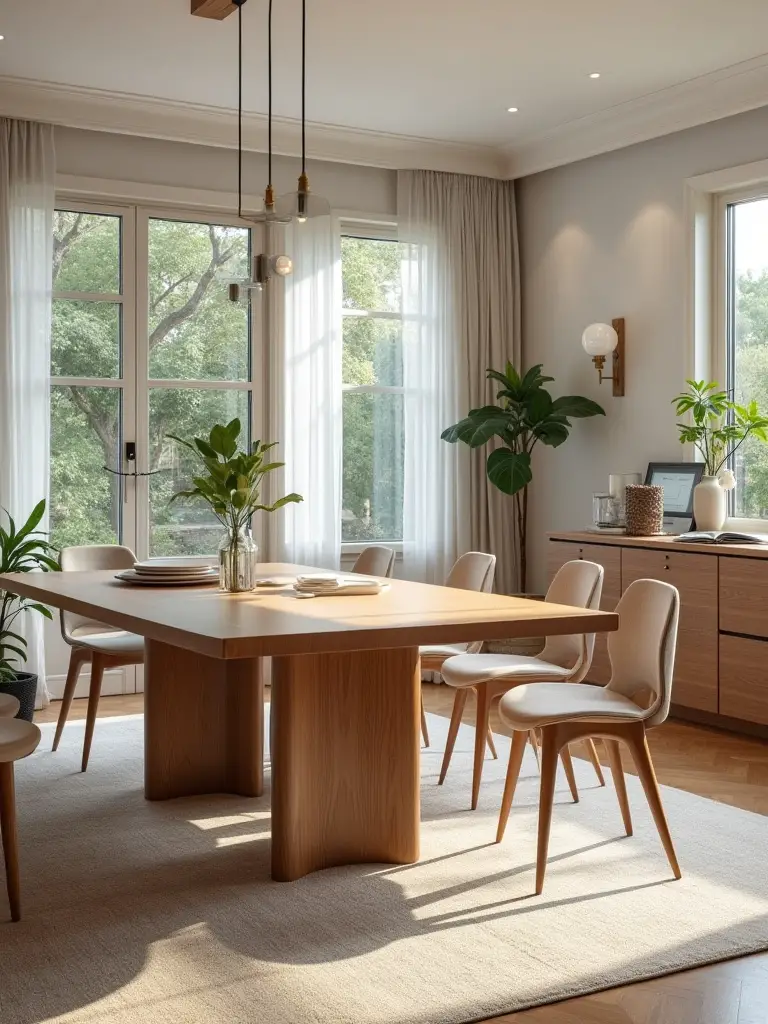
Designing a room for a life you don’t lead is the fastest way to waste money and create a space that feels utterly useless. If your reality involves daily family meals and work calls, you need durable surfaces, comfortable chairs you can sit in for hours, and perhaps integrated, discreet storage for a laptop and papers. That is a far smarter investment than a delicate, hand-lacquered table that you’re too terrified to use. Your room should serve your life, not the other way around.
3. Establish a Cohesive Style or Theme Direction
People hear “theme” and they think of something kitschy. That’s not what this is. Think of it as the room’s narrative. What is the story? Is it quiet luxury, dramatic elegance, modern minimalism, or rustic warmth? This narrative is the filter through which every single decision should pass, from the chandelier down to the napkins. It prevents the room from feeling like a random collection of nice things.
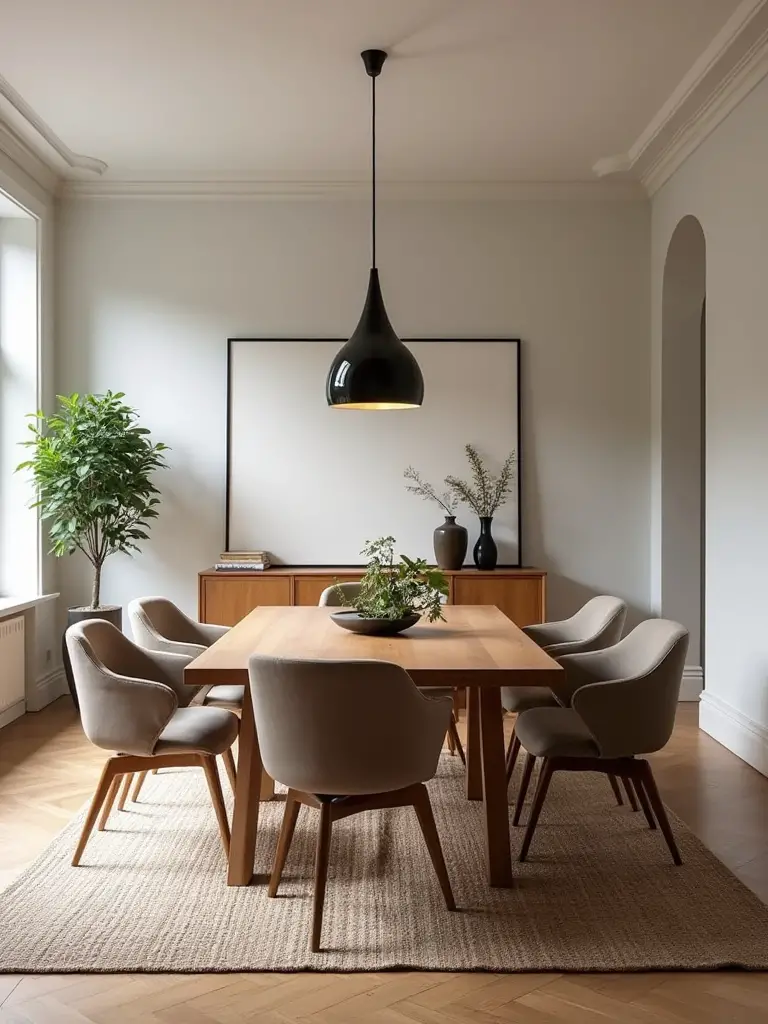
The best way to do this is to create a visual brief—a Mood Board, but more focused. Collect images not just of dining rooms, but of textures, colors, and feelings you’re drawn to. A piece of art, a fabric swatch, a photograph of a landscape. Soon, you’ll see a common thread. That thread is your theme. I had a client who was struggling, and we discovered that all her inspiration images had a deep, moody quality. We leaned into that, with dark teal walls, velvet chairs, and brass accents. The result was cohesive and intensely personal.
4. Strategically Place Lighting Fixtures for Ambiance and Function
Can we talk about lighting? It is the most powerful tool in your design arsenal, and it’s criminally misunderstood. Relying on a single, blazing chandelier in the center of the room is a design crime. It casts harsh shadows and makes everyone look tired. It’s the opposite of the “linger factor.” True luxury is about creating layers of light.
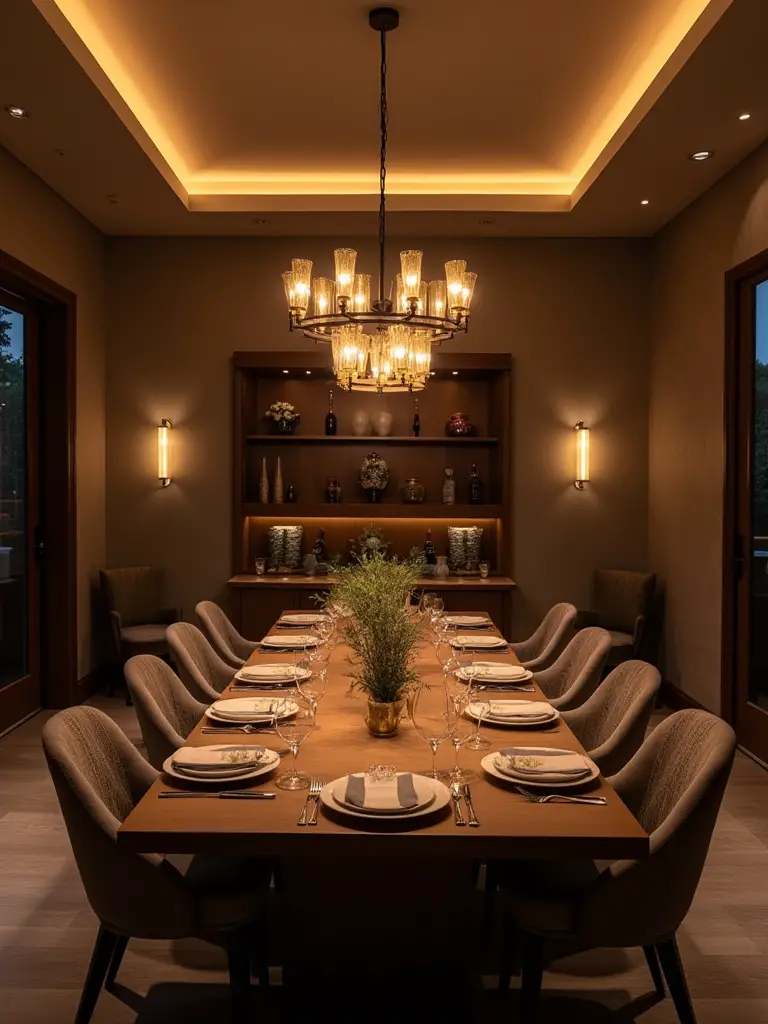
Every dining room needs three types of lighting. First, ambient light, which is the overall glow—yes, that can be your chandelier. Second, task light, focused directly on the table. And third, accent light—think sconces, a lamp on a buffet, or a picture light over art. Critically, every single one of these should be on a dimmer. Dimmers are non-negotiable. They are the single most important and cost-effective upgrade you can make, allowing you to shift the mood from bright and functional to low and intimate in an instant.
Laying the Foundation: Planning for Your Dream Dining Space (Part 2)
We’ve covered the invisible architecture of the space—flow, function, and light. Now let’s get into the surfaces that define the room’s character from the ground up. These are foundational decisions that impact everything from acoustics to the daily feeling of being in the space. Get these right, and the rest of the puzzle pieces fall into place so much more easily.
5. Select Flooring Materials for Durability and Aesthetic Appeal
Please, I beg you, do not put wall-to-wall carpet in a dining room. It’s a cleaning nightmare just waiting to happen, trapping every crumb and wine spill. For a space dedicated to sophisticated entertaining, you need a surface that is both elegant and forgiving. Hardwood is classic for a reason—it’s beautiful, timeless, and can be refinished for decades. Large-format porcelain tile can feel incredibly chic and is virtually indestructible.
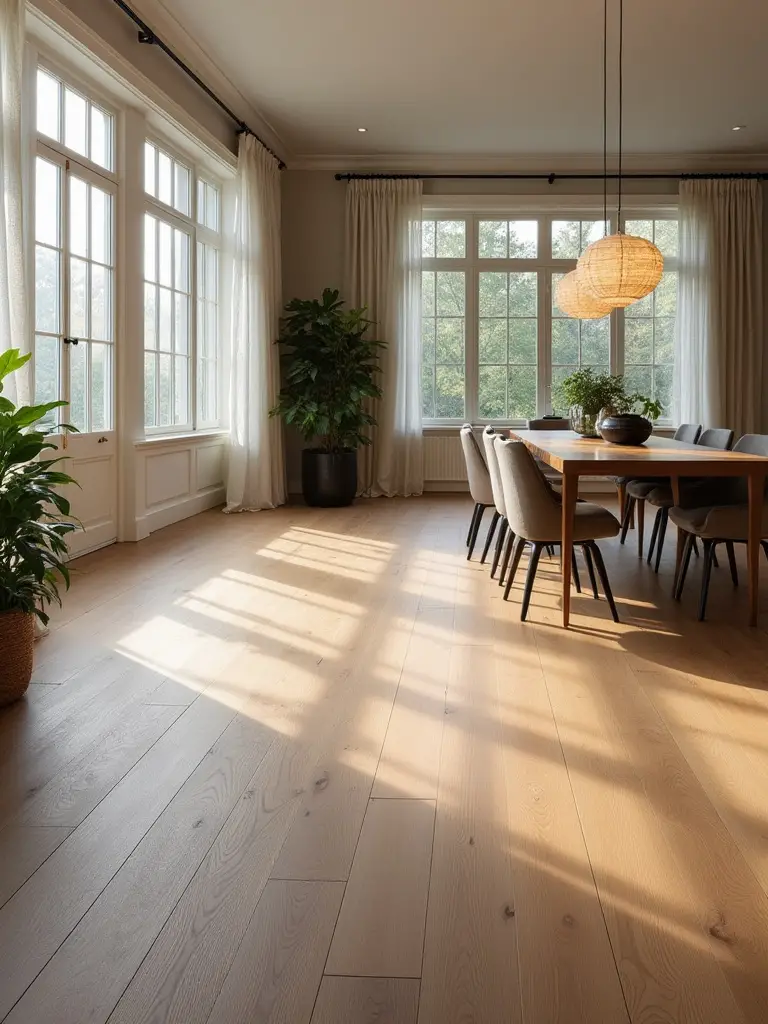
My secret weapon for clients with children or a love for red wine? High-quality luxury vinyl plank. I know what you’re thinking, but the technology is extraordinary now. It can mimic wood or stone with breathtaking accuracy, and it’s built to withstand a war zone. I installed a dark, wide-plank LVP in a client’s formal dining room, and at their first dinner party, a guest dropped an entire bottle of merlot. After a moment of panic, we simply wiped it up. No stain, no damage. That peace of mind is true luxury.
6. Choose a Color Palette to Set the Mood and Reflect Your Personality
Color is emotion. It’s the first thing people register when they walk into a room. So, what do you want them to feel? Don’t just default to a safe beige because you’re afraid to commit. Dining rooms, which are often used in the evening, are the perfect place to embrace drama and mood. Rich, saturated colors come alive in candlelight.
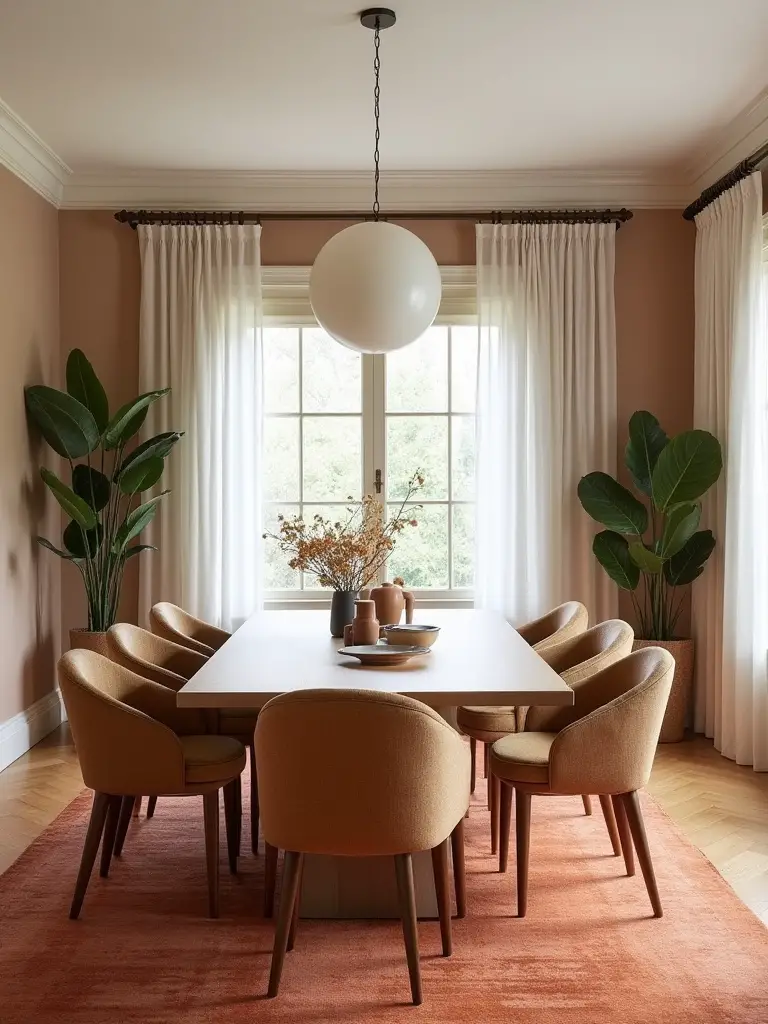
Think about deep blues, charcoal grays, rich greens, or even a warm, earthy terracotta. These colors envelop the space and create an intimate, cocoon-like feeling that encourages conversation. If you’re nervous, start by painting just one accent wall. I always advise clients to get large sample swatches and paint them on poster board. Move them around the room throughout the day and observe how the color changes with the light. What looks perfect in the morning might feel completely different under your chandelier at night. Never, ever pick a color from a tiny chip under fluorescent store lighting.
Curating Your Dining Room: Furniture & Core Elements (Part 1)
Now for the main event—the pieces that will host your gatherings. This is where you make your biggest investments, so the focus must be on quality, comfort, and timelessness. These are the core elements that will define your dining room for decades, so choose wisely. It’s not about trends; it’s about heritage pieces.
7. Prioritize Table Shape and Size for Seating Capacity
We’ve already talked about leaving enough space around the table, but the table’s shape is just as important. A rectangular table is a classic for a reason—it works beautifully in most rooms. But a round table is the undisputed champion of conversation. There’s no head of the table, so everyone feels equally included, and the conversation flows more naturally. For smaller or square rooms, they are often the perfect solution.
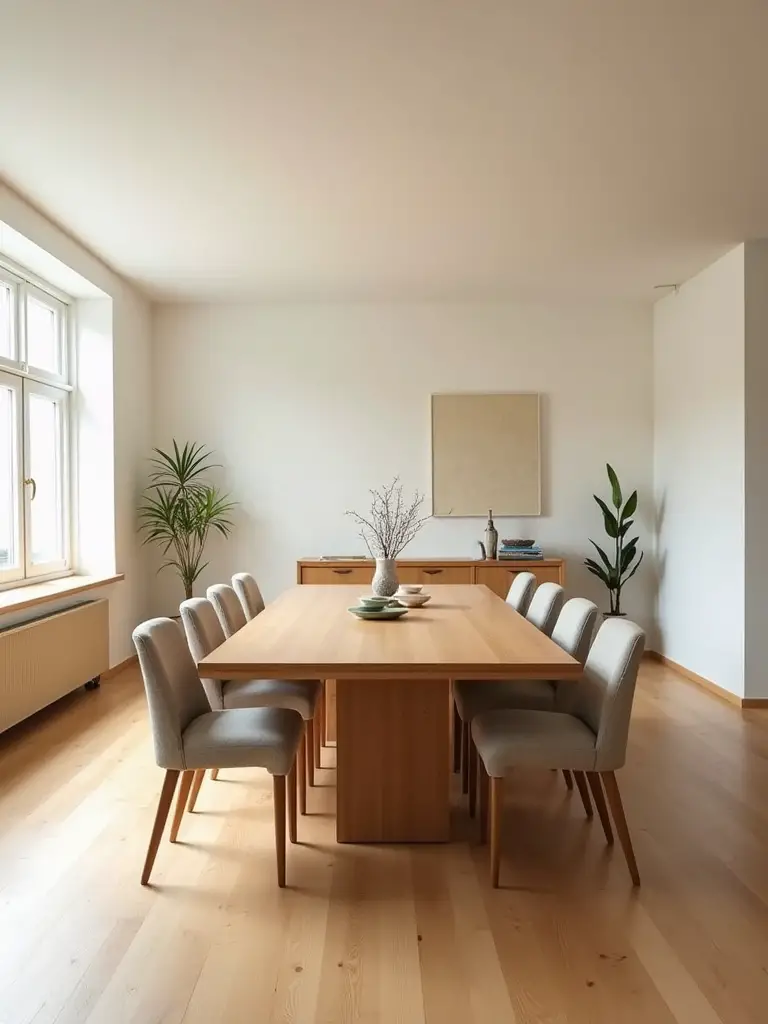
An extendable table is the smartest investment for anyone who entertains. It gives you the flexibility to live comfortably day-to-day without being saddled with a massive table, but allows you to expand gracefully for holidays and bigger gatherings. A little secret: a pedestal base, especially on a round table, is a gift. It eliminates the legs at the corners, which always seem to be in someone’s way, allowing you to squeeze in an extra guest or two with ease.
8. Invest in Comfortable Dining Chairs for Prolonged Enjoyment
If you take away only one piece of advice from me today, let it be this: your dining chairs are more important than your dining table. A chair is the silent host of your dinner party. If it’s uncomfortable, it is subtly, insistently telling your guests that it’s time to leave. I don’t care if you have a million-dollar table—if people are shifting uncomfortably and getting sore after 45 minutes, you’ve failed.
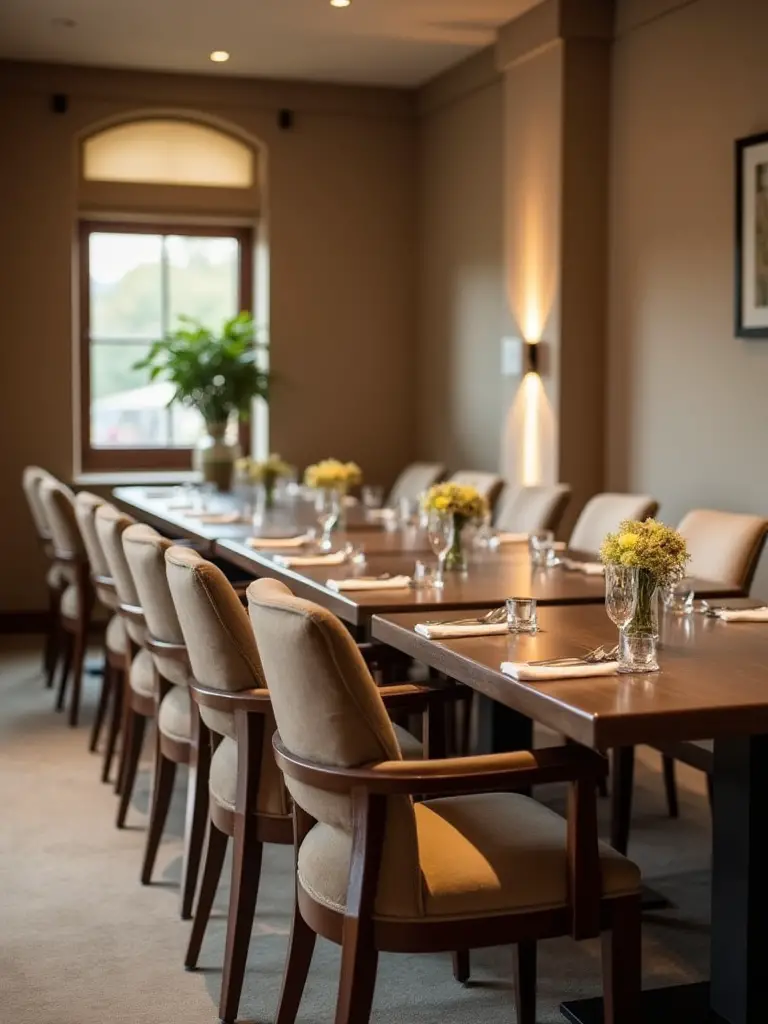
The “linger factor” lives and dies with your chairs. Look for upholstered seats, a supportive back, and proper proportions. The seat should be high enough that your legs are comfortable but low enough to slide easily under the table’s apron (the frame beneath the tabletop). Always, always test a chair before you buy it. Sit in it for at least ten minutes. If you’re not completely comfortable, no one else will be either. This is the single best place to allocate a significant portion of your budget.
9. Integrate Smart Storage Solutions with Sideboards or Buffets
Clutter is the enemy of sophistication. A sideboard or buffet isn’t just a pretty piece of furniture; it’s your command center. It’s where you store your extra linens, serving platters, flatware, and candles, keeping them out of sight but within easy reach. This prevents you from having to run back and forth to the kitchen during a meal, which keeps the flow of the evening uninterrupted.
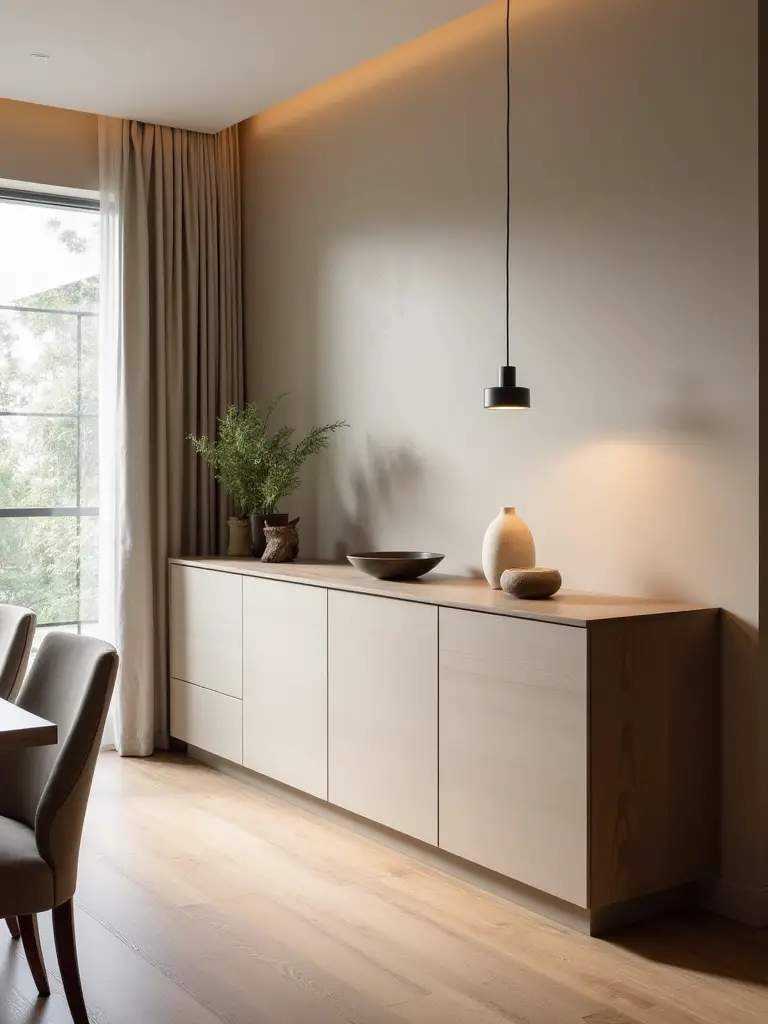
During a party, it also serves as a crucial secondary surface. It can be a drink station, a dessert bar, or the place to set down hot dishes for serving family-style. This frees up precious real estate on the dining table itself, allowing more room for elbows, wine glasses, and a beautiful centerpiece. When choosing one, make sure the style complements your dining set without matching it perfectly—a little contrast adds depth and character.
10. Introduce Statement Artwork to Define a Focal Point
Every room needs a soul, and in the dining room, that soul is often a piece of statement art. This is your opportunity to be bold. Don’t be timid with scale—a common mistake is choosing a piece that is too small for the wall, making it look like a postage stamp. As a rule of thumb, the art should be about two-thirds the width of the furniture below it, like your sideboard.
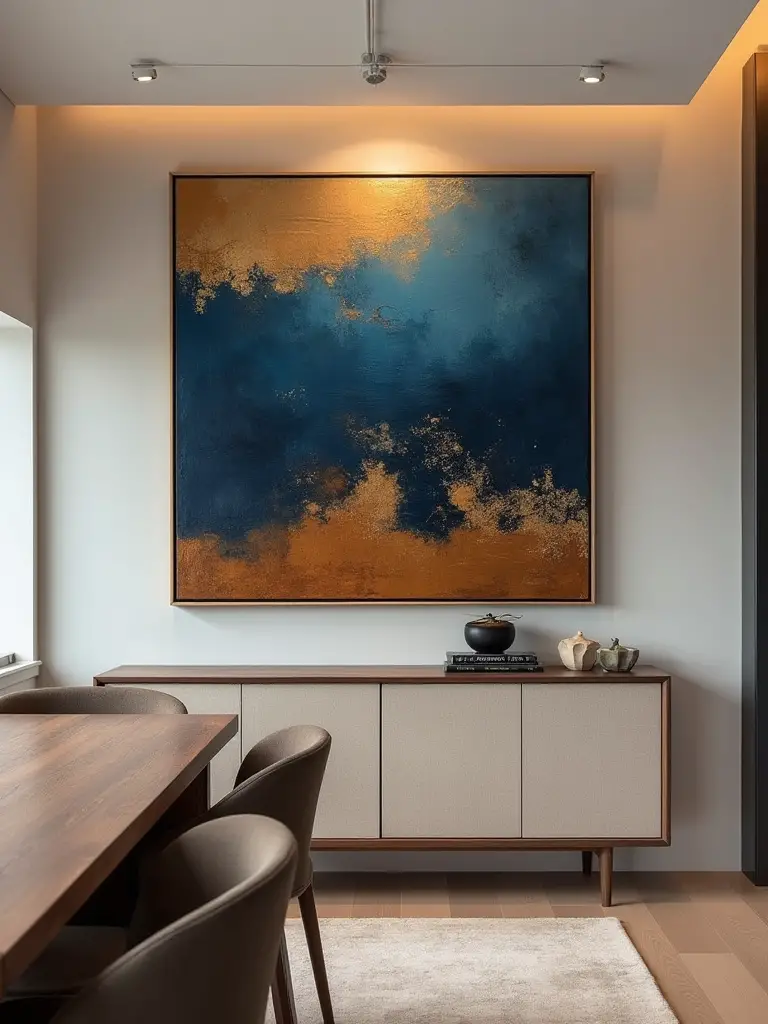
The art you choose sets the tone for the entire room. It can inject color, energy, and personality. It also serves as an incredible conversation starter. And please, hang it at the right height. The center of the piece should be at eye level, roughly 57-60 inches from the floor. I’ve seen more gorgeous art ruined by being hung too high than I can count. It should feel connected to the room, not floating away from it.
Curating Your Dining Room: Furniture & Core Elements (Part 2)
We’ve covered the heavy hitters. Now, let’s refine the space with the supporting players that control the atmosphere and elevate the experience. These elements soften the hard edges, manage the environment, and add that crucial layer of thoughtful hospitality that makes guests feel truly cared for.
11. Select Window Treatments for Light Control and Privacy
Window treatments are the finishing touch that frames your view and controls the mood. Bare windows can feel stark and unfinished, especially at night when they become black, reflective mirrors. The key here is versatility, which is why I almost always recommend layering. Start with a functional layer for privacy and light control, like woven wood shades or simple roller blinds.
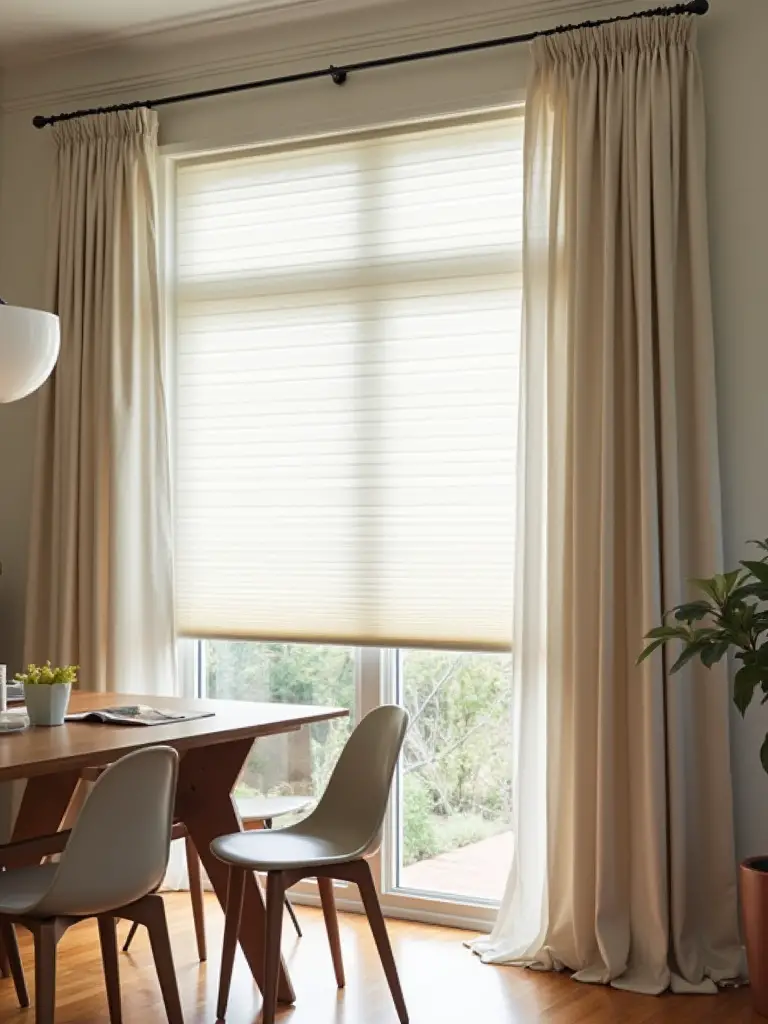
Then, add a decorative layer with drapery. Hanging long drapes—even simple linen panels—adds softness, texture, and a touch of elegance. A professional tip: mount the curtain rod high, several inches above the window frame and close to the ceiling, and extend it 6-12 inches on either side. This trick makes your windows look substantially larger and grander, adding a sense of height and occasion to the room.
12. Choose an Area Rug to Anchor the Dining Set and Add Texture
An area rug is like a frame for your dining set. It defines the dining zone, adds warmth, and absorbs sound, which is crucial for reducing echo in a room with many hard surfaces. The most common and unforgivable mistake is getting a rug that’s too small. All four legs of a dining chair must remain on the rug, even when the chair is pulled out.
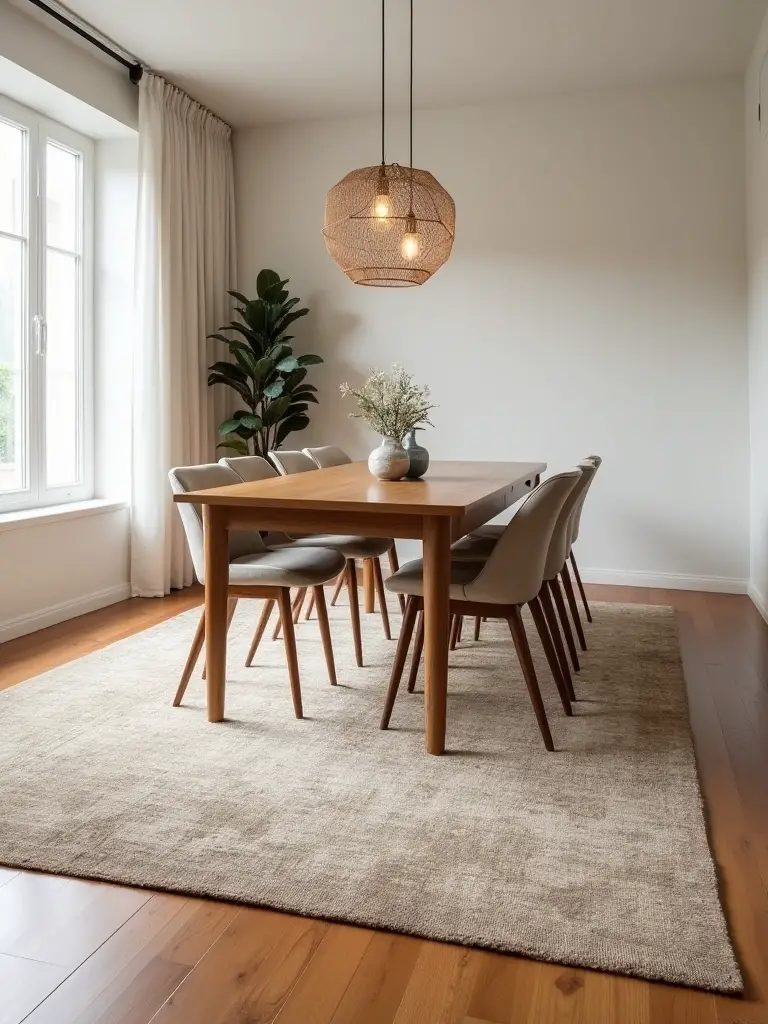
To get this right, measure your table and add at least 24-36 inches on all sides. This usually means an 8×10 or 9×12 rug for most standard tables. Anything smaller looks cheap and is a tripping hazard. For material, choose something low-pile and easy to clean. Wool is a fantastic, naturally durable option. A brilliant shortcut for high-traffic homes? A high-quality indoor/outdoor rug. They are unbelievably stain-resistant, come in beautiful designs, and can be spot-cleaned with ease.
13. Consider a Bar Cart or Coffee Bar for Added Hospitality
This is about making your guests feel welcome and self-sufficient. A beautifully styled bar cart is more than just a place for liquor; it’s an invitation. It says, “Please, help yourself. Make yourself at home.” It also frees you, the host, from playing bartender all night. Stock it with a few key spirits, some nice glassware, an ice bucket, and a few garnishes.
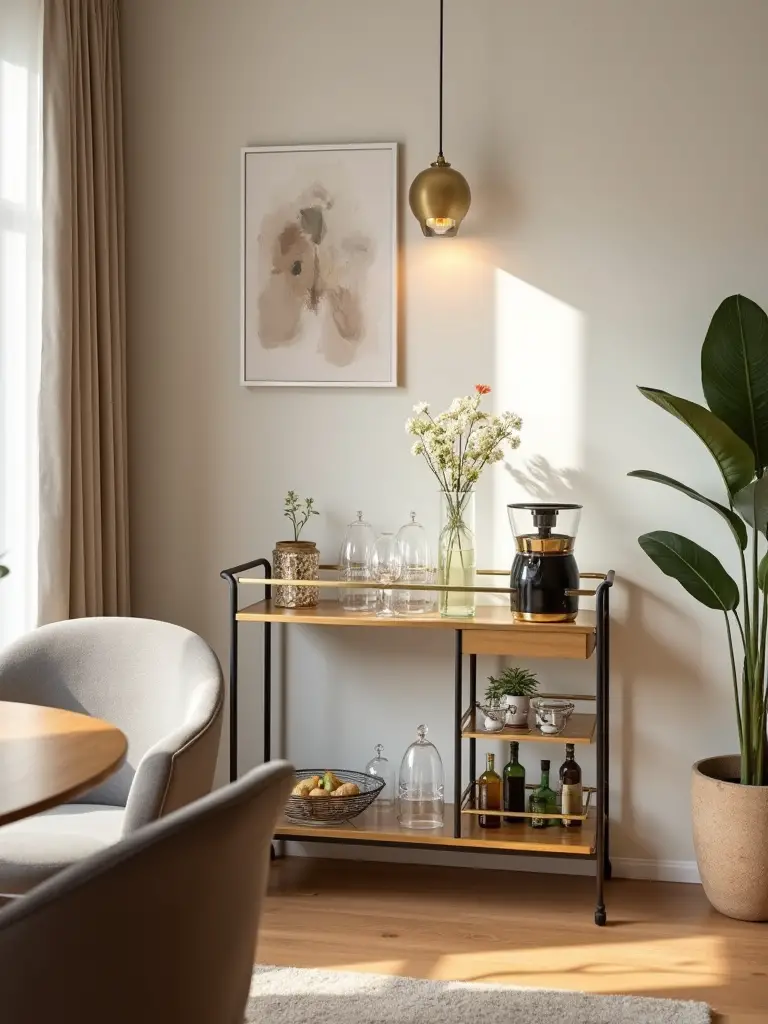
If cocktails aren’t your style, the same principle applies to a coffee bar. A small credenza with an elegant coffee machine, cups, and sweeteners creates a lovely, self-serve station for after-dinner coffee or brunch. It’s a small touch, but it signals a level of thoughtful hospitality that guests remember. It breaks down formality and encourages a more relaxed, communal atmosphere.
Elevating Your Space: Styling and Finishing Touches (Part 1)
With the foundation and furniture in place, it’s time to bring the room to life. Styling is where your personality truly shines. These are the layers that add intimacy, visual interest, and character. This is the difference between a furniture showroom and a home.
14. Master the Art of Dining Table Centerpiece Design
The centerpiece is the heart of the table, but people get so intimidated by it. Forget massive, formal floral arrangements that block everyone’s view. The golden rule is that guests should be able to make eye contact over the centerpiece without craning their necks. Anything taller than about 12 inches is a barrier to conversation.
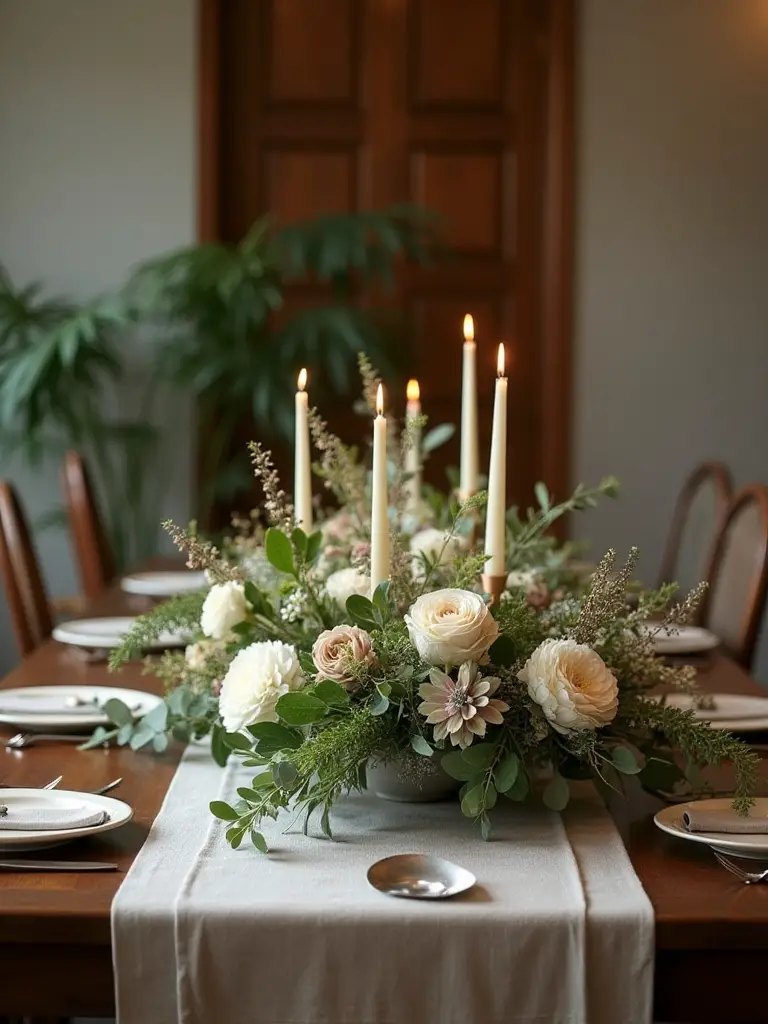
Instead, think low and layered. A cluster of candles at varying heights, a collection of small bud vases with single stems, or a beautiful bowl filled with seasonal fruit or decorative objects can be far more impactful. I love using a long, narrow tray or a simple linen runner as a base. It contains the arrangement and makes it feel intentional, even if it’s just a few simple items.
15. Incorporate Greenery with Plants or Floral Arrangements
Every room needs life, and nothing provides that more easily than greenery. A large potted plant, like a fiddle leaf fig, in a corner can add height and architectural interest. On the sideboard, an orchid or a simple vase of fresh-cut branches adds an elegant, sculptural touch. It doesn’t have to be complicated.
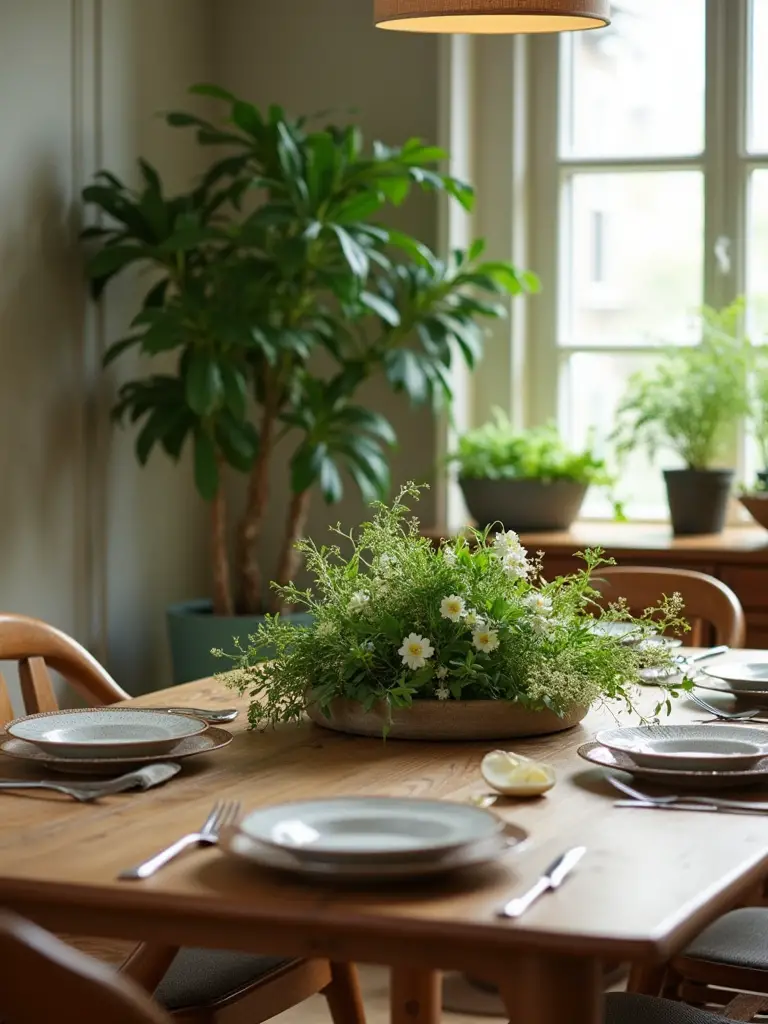
On the table itself, just be mindful of scent. Overly fragrant flowers like lilies can compete with the aroma of the food, which can be distracting and even off-putting. Stick to unscented blooms or, my personal favorite, arrangements of interesting leaves, herbs, or branches. They provide the same visual benefit without interfering with the culinary experience.
16. Curate Open Shelving or Display Cabinets Thoughtfully
Open shelving is not general storage; it’s a stage. It’s an opportunity for a carefully curated moment. The trick is to edit ruthlessly. Choose only your most beautiful serving pieces, glassware, or decorative objects. Mix in items with personal meaning alongside functional pieces. And most importantly, leave some empty space.
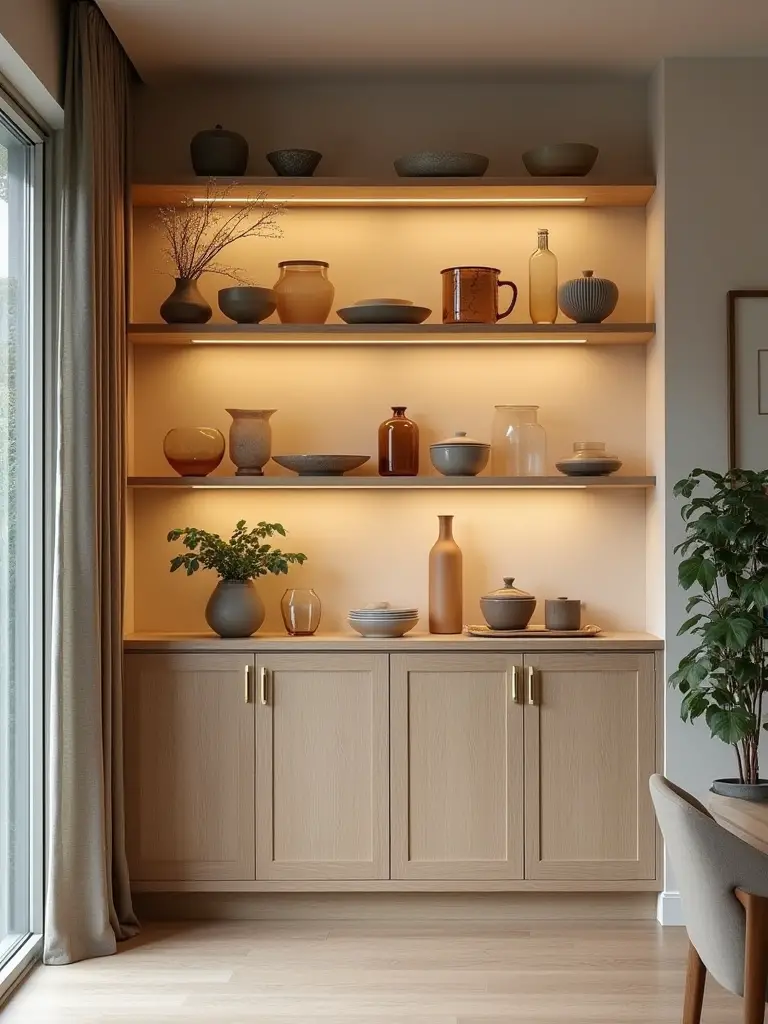
“Every item on display should be beautiful, functional, or tell a story. If it doesn’t fit one of those categories, it probably doesn’t belong.”
Negative space, or “breathing room,” is essential. It allows each object to be seen and appreciated. Group items in odd numbers—threes or fives—and vary the heights and textures for a dynamic composition. A crowded shelf looks like clutter; a curated one looks like art.
17. Layer Textures with Linens, Pillows, and Decorative Objects
Texture is what makes a room feel rich and inviting. It’s the subtle interplay of different surfaces that pleases the eye and invites touch. Think beyond just color and pattern. Imagine a smooth wooden table topped with a nubby linen runner, crisp cotton napkins, matte ceramic plates, and sparkling glassware. It’s a symphony of textures.
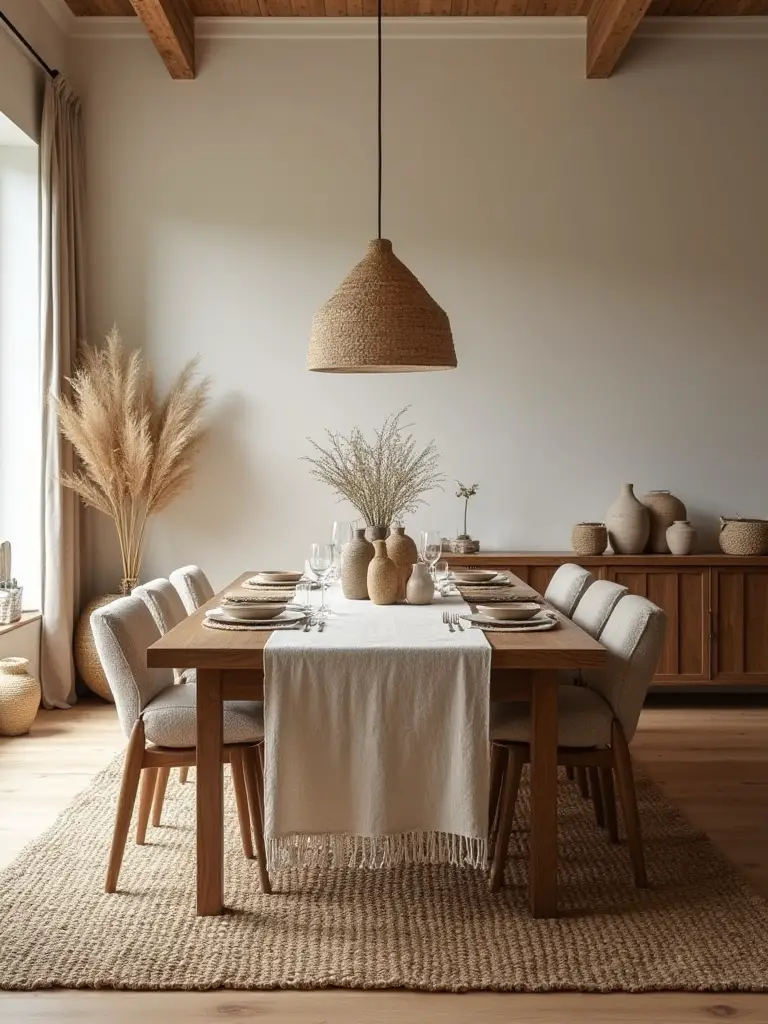
Don’t forget the chairs. A simple velvet or wool cushion can add a layer of comfort and softness. A plush rug underfoot contrasts beautifully with the hard surfaces of the table and floor. On a buffet, place a smooth marble tray next to a rough, woven basket. This layering of tactile sensations is what makes a space feel deeply considered and luxurious.
Elevating Your Space: Styling and Finishing Touches (Part 2)
We’re almost there. These final touches are the polish. They’re the clever, professional strategies that enhance the room’s inherent qualities and infuse it with your unique spirit. This is where you make the space unequivocally yours.
18. Utilize Mirrors to Expand the Perception of Space and Light
A large mirror is an old designer trick for a reason: it works. It’s like adding another window to the room. Placed strategically, it can bounce light around a dark space and create the illusion of depth, making a small room feel significantly larger. The ideal placement is often on the wall opposite a window to reflect the natural light and the view.
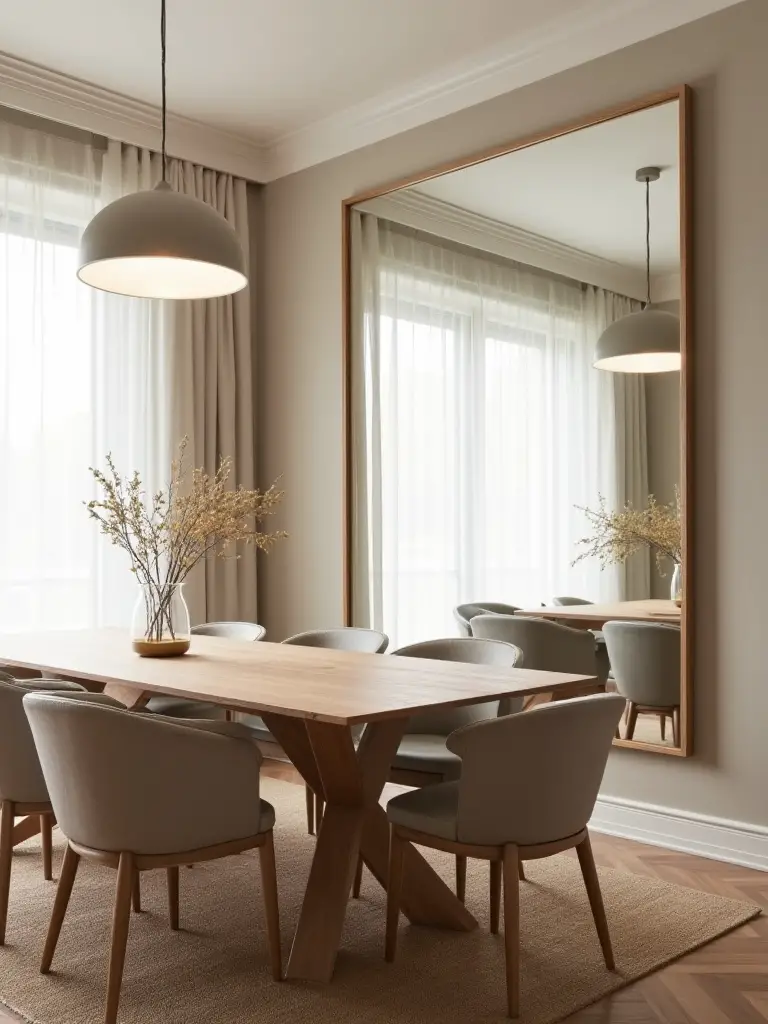
Choose a frame that acts as a piece of art in its own right, something that complements the style of your room. But be mindful of what it’s reflecting. There’s nothing worse than a beautiful mirror that gives you a perfect view of a cluttered corner or a boring, blank wall. Make sure it reflects something lovely, like your chandelier, a piece of artwork, or the view outdoors.
19. Add Personalized Elements Reflecting Your Family’s Story
This is what truly transforms your house into a home. A sterile, perfectly designed room can feel cold and impersonal. Your dining room should tell your story. This is the place to create a gallery wall of family photos, display an heirloom piece of silver passed down from your grandmother, or showcase pottery you collected on a memorable trip.
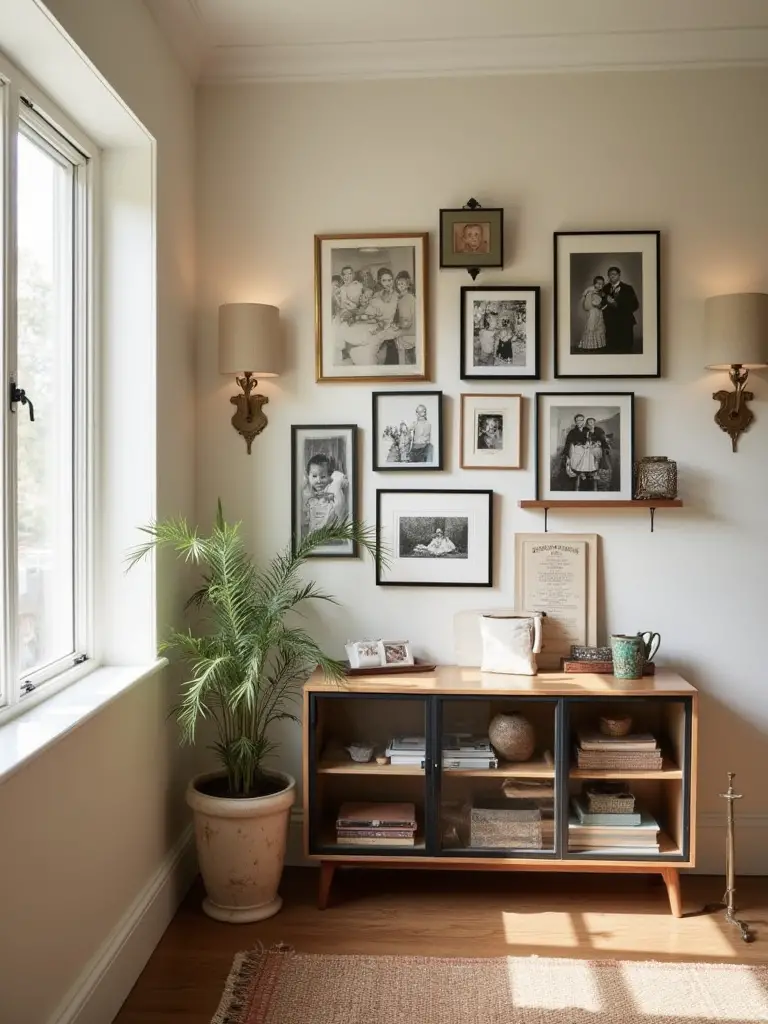
These elements are the real conversation starters. They invite guests to ask questions and learn more about you. It’s what makes your space unique and authentic. A client of mine framed her children’s early drawings in elegant, oversized mats and simple black frames. They looked like stunning Abstract art, but they were deeply personal and a constant, beautiful reminder of her family’s story. It is these touches that create a home with a heart.
Conclusion
So you see, creating dining room inspiration isn’t about copying a single look. It’s a thoughtful process of layering function, comfort, and personality. It begins with an honest assessment of your space and your life and culminates in a room that not only looks beautiful but feels intrinsically right. It’s a space that encourages you to slow down, connect with the people you love, and create memories that will last far longer than any design trend.
Your dining room has the potential to be the most magnetic room in your home—the one that draws everyone in and holds them captive with good food and even better conversation. Don’t be afraid to make bold choices, to invest in quality, and above all, to infuse the space with your own story. Start with one idea, whether it’s simply adding dimmers or finding the perfect art piece, and let the transformation begin. Create a space that invites you, and your guests, to linger.
